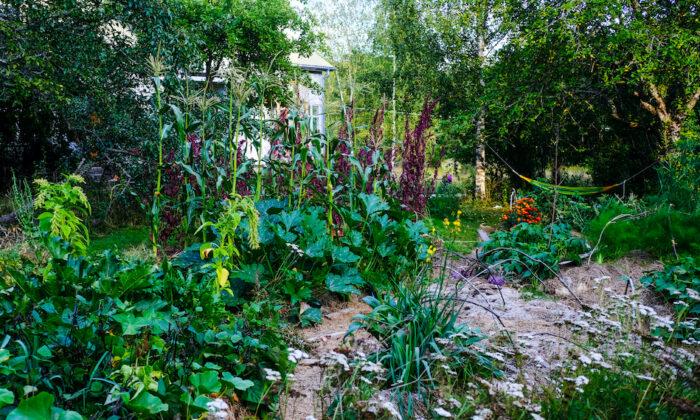In the West, we’re used to seeing lawns everywhere. A well-manicured lawn may even be said to be part of the “American dream,” offering a great place to relax, a clean foreground to our homes, and a place for children to play. But there is another side to lawns as well.
Some people take a notably dim view of lawns, and they may have good reason. While lawns have their advantages over non-living landscapes, most are destructive monocultures that work against the principles of nature. Tens of thousands of tons of pesticides are used for lawn maintenance every year in the United States alone, and many contain known carcinogens and neurotoxins.
Food, Well-Being, and Self-Reliance
There is no sugarcoating it. Price inflation and supply chain disturbances have people understandably concerned about food. The pandemic and war abroad are affecting the global food supply. Westerners are having to face a hard truth: We are too dependent on the centralized, industrial agriculture system for our food.The majority of grocery store food comes from hundreds, or even thousands, of miles away. Along its journey, it is repeatedly handled, shipped, and stocked, losing nutrients during its entire journey to your refrigerator. The majority of fruits and vegetables lose more than 50 percent of their nutrients within just a week of harvest. Spinach can lose most of its vitamin C within a day after harvest.
Not only do big agriculture’s monoculture crops destroy the mineral and microbial health of the soil with the use of chemical fertilizers, pesticides, and heavy machinery; the food they produce is nutrient deficient and some of our largest crops are genetically modified.
Unless we are supporting local farms, and questioning their practices, we aren’t getting the most nutritious food. We have all heard how the topsoil is degenerating, nutrient density is diminishing, and pesticide use is running rampant. Glyphosate is spreading from our food to our water and our bodies.
If there is a positive lesson we can take from history, it’s that when life gets tough, the tough get growing. During World War II, individuals and communities were growing 40 percent of the vegetables in the United States. “Victory gardens” were responsible for producing 1 million tons of vegetables during the war. The food also was naturally organic.
Being outside, putting your hands in soil, watching life grow—these are beautiful experiences that nurture well-being. Unfortunately, too many of us have forgotten, or think it is beyond our ability to grow our own food. Many of us were never meaningfully exposed to this knowledge. Our parents kept a lawn instead of a garden, or we grew up in urban spaces with limited garden space. One of the best ways to gain a sense of control amid the turbulence of modern times is to find ways to support ourselves. Gardening is one of the most rewarding acts of self-sufficiency we can practice. It’s not a hobby for “nature-lovers.” It’s part of a healthy, holistic, human experience. It’s also a great way to stay well and save money.
If you do have a lawn, you have an incredible opportunity. While industrial agriculture has refined a method of “food production” that works well with machines and huge distribution chains, other people have been experimenting with a more intimate form of agriculture based on maximizing how much food they grow with the least possible effort.
Many of these people are now on a mission to help others do the same. Jim Gale is one of the people proselytizing the beautiful idea of “food forests” through his company Food Forest Abundance. Gale speaks about how there are 40 million acres of lawn in the United States alone and that transforming a small percentage is “the idea whose time has come ... food forests everywhere.”
Food Forest Abundance
Permaculture, or permanent agriculture, mimics natural ecosystems with a perennial, multi-layered approach to growing food. Plants benefit each other and the soil through synergistic groups known as “guilds.” By promoting biodiversity, greater abundance and health is achieved in the whole system. The reason many people think they have a “black thumb” is because they probably weren’t gardening in alignment with nature. A natural forest doesn’t need human help. By working with the properties of nature, plants that feed us can thrive with minimal effort down the line.Permaculture experts know what to plant and where to plant it, based on an area’s climate, space, planting zone, and topography, as well as for the beauty, functionality, and amount you wish to grow. As explained at FoodForestAbundance.com: “Unlike a farm that cultivates a single crop in a vertical position, food forests utilize up to eight different growth layers found in the woods. The focus is on growing plants that benefit each other and promote growth and a healthy ecosystem.”
With an emphasis on trees, seed-saving plants, and perennials, this method of gardening can turn an excellent return on investment over time. For example, a fruit tree can produce hundreds of fruits per year, and learning to save seeds can provide a lifetime of returns.
Food Forest Abundance sells personalized permaculture blueprints for people’s yards based on all of these factors. You can also find permaculture designers in your area that are familiar with the plants and ecology. In many cases, you can find local groups of people supporting each other in their efforts to install and develop permaculture systems. If you purchase a plan, you can install it yourself or hire a landscaping business to help you.
The Food Revolution Is Now
Even urban settings such as Detroit are seeing a shift toward community agriculture. The Michigan Urban Farming Initiative is now a 501(c)(3) nonprofit organization that seeks to engage members of the Michigan community in sustainable agriculture. “Agrihood” is a term that describes an urban neighborhood with dedicated community farming.Detroit’s “agrihood” now covers three acres and grows hundreds of varieties of crops that provide food to 200 households, local markets, restaurants, and charitable food pantries in Detroit. About 10,000 volunteers have contributed to the effort. This is local, decentralized empowerment that has the power to heal and regenerate communities.
Similar farm-to-table community efforts are happening around the world. In documentaries such as “Kiss the Ground” and “The Biggest Little Farm,” millions of people have learned about the regenerative agricultural movement. Permaculture and regenerative farming are being embraced as true solutions to the problems we collectively face. Healthy food is a God-given right in which we exercise collective and personal responsibility. If we want to take back our health, it all starts with our connection to food, water, and the dense network of life that resides within the soil.







Friends Read Free